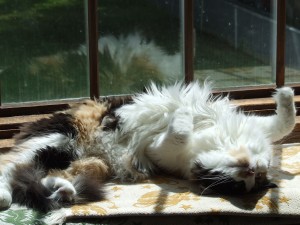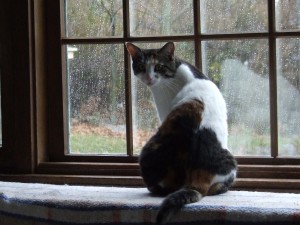Written by Tracy Dion, August 2012, and updated and published in ‘Catnip Chronicles,’ November 2012.
 There is a lot of confusion around how often a domesticated cat should be fed. Most cats are either free-fed or fed only once or twice a day, and convenience to the owner is the driving factor.
There is a lot of confusion around how often a domesticated cat should be fed. Most cats are either free-fed or fed only once or twice a day, and convenience to the owner is the driving factor.
But is this good for the cats?
Let’s look at the science first. According to the National Research Council’s Nutrient Requirements of Dogs and Cats, feral cats eat about 8 to 12 meals in any given 24 hour period. (1) Their behavior is geared towards small, frequent meals and they spend a great deal of their time actively hunting.
Their digestive physiology is affected by their eating habits. Smelling food triggers a cat’s digestive system to begin working, and constantly smelling food – as free-fed cats do – keeps that system primed and ready to go all day. Like all physiological functions, the GI tract requires energy to operate; constantly keeping it “on” pulls resources from other systems and, depending upon the quality of nutrition the cat routinely receives, can cause problems including premature aging, poor coat quality, and chronic cystitis.
In addition, a carnivore’s digestive physiology has incorporated hunger as an integral part of its healthy workings. Indigestible solids are retained in the stomach until digestion of other food products is completed and it is, in fact, hunger pangs which propel this material forth. If the cat is never allowed to become hungry, the regulation of waste movement is compromised, leading to discomfort, hairball regurgitation and other digestive motility issues.
Clearly, then, free-feeding is not a healthy practice. (And this does not even touch upon the lack of quality content in the kibble products so readily available to these cats, or the many links between that content and today’s leading feline disease and premature deaths. See No Kibble! for more on that.)
On the other end of the spectrum, the cat’s stomach can’t expand like the dog’s to accommodate large meals, and cats can – and often do – regurgitate if fed too much at one time, as might happen with a cat fed only once or twice daily.
Eating too fast, which cats tend to do when they are very hungry, can also cause discomfort and regurgitation of the meal.
Too, as the cat becomes hungry, bile acids in the stomach increase in anticipation of a meal. If this goes on too long or becomes concentrated enough, the cat is likely to become nauseous, provoking what many have termed “hunger pukes”, typically of a clear or foamy consistency. “Too long” varies with the cat, but can be as short as 5 or 6 hours without food. Unfortunately for some cats, this puking can start a spiral of discomfort that will throw a cat off food indefinitely.
In all of these cases, even when the cat doesn’t become actively sick, she’s probably not feeling quite as comfortable as she should.
Furthermore, as Dr. Lisa Pierson notes on her site, CatInfo.org, the frequency of a cat’s meals impacts the PH of her urine. (2) ‘Post-prandial alkaline tide’ refers to the increase in urine alkalinity that follows the ingestion of a large meal, a PH change that can lead to the formation of painful and potentially deadly struvite crystals. Eating smaller, more frequent meals – mimicking their instinctive hunting behavior – naturally helps maintain a cat’s PH in the normal range.
Finally, a study published in the February 2014 issue of the Journal of Animal Science, “Effects of feeding frequency and dietary water content on voluntary physical activity in healthy adult cats,” (3) determined that more frequent meals had a positive impact upon feline activity, making weight loss and maintenance easier… an important fact given the 90% increase in feline obesity cases over the last five years. (3) (Interestingly, this study also showed, once again, that a high moisture diet was more beneficial for cats than a dry one.)
Obviously, then, feeding only once or twice a day isn’t a good idea either.
So how often should a cat be fed?
A minimum of three times a day for adults, four if you can manage it, and at least four times a day for kittens. Three times a day is easy to do if you feed shortly after you rise in the morning, immediately after you arrive home from work, and last thing before you retire for the night.
If your schedule disallows this, you can either pay someone to come by during the day, or purchase one of the many timed feeders available on the market today… several of which are capable of disseminating canned or raw foods. (Just don’t feed kibble!)
 Stick to a routine, as this will help enormously in managing feline stress levels and is beneficial for that as well as digestive reasons, and feed as large a rotation of low-carb canned or raw foods as you can get your hands on.
Stick to a routine, as this will help enormously in managing feline stress levels and is beneficial for that as well as digestive reasons, and feed as large a rotation of low-carb canned or raw foods as you can get your hands on.
Never fast a cat!
Unlike dogs – whose hunting behavior includes gorging and fasting – fasting is an unhealthy practice that is unnatural to cats. At minimum, it will cause a seriously hungry and uncomfortable cat, and at worst, it could provoke a case of hepatic lipidosis. One of the most common feline liver diseases, hepatic lipidosis, or fatty liver disease, can rapidly lead to serious complications and even death, especially in cats that are overweight.
Feeding at least three scheduled, low or no-carb canned or raw meals a day will go a long way toward keeping your cat’s digestive system healthy, strong, and working at peak efficiency!
References
1. National Research Council’s Nutrient Requirements of Dogs and Cats
2. Dr. Lisa Pierson CatInfo.org, May 2014.
3. P. Deng, E. Iwazaki, S. A. Suchy, M. R. Pallotto, K. S. Swanson. Effects of feeding frequency and dietary water content on voluntary physical activity in healthy adult cats. Journal of Animal Science, 2014; DOI: 10.2527/jas.2013-7235
4. State of Pet Health 2013 Report, Banfield Pet Hospital, May 2013.
If you enjoyed this article or found it informative, please “Like” it, “Tweet” it, or share it using any of the buttons below. And don’t forget to check out our FB page, join the discussions in our awesome FB group and follow us on Twitter!
Created 10/05/12; Updated 08/20/14


Pingback: Getting the Basics Straight | Raw Feeder Unleashed